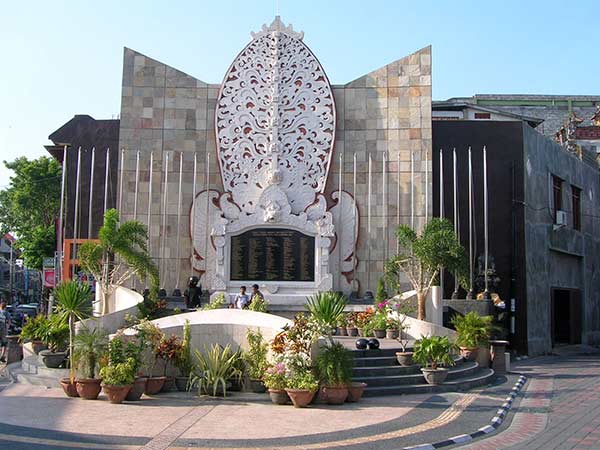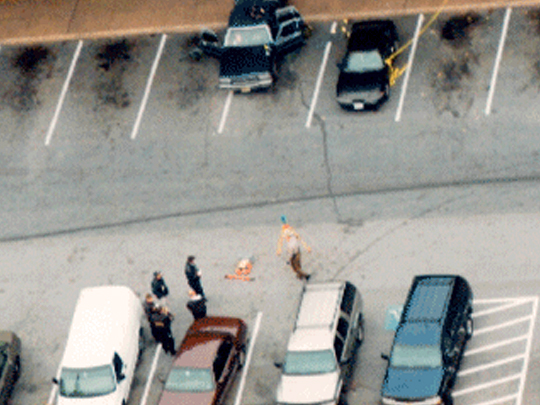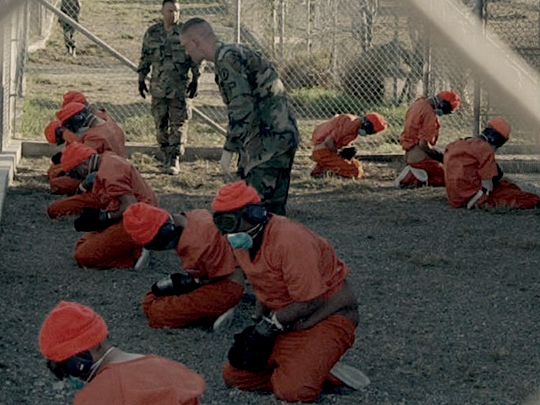Photo by Shane T. McCoy, U.S. Navy / Wikimedia Commons / CC-BY-SA-3.0 / GFDL
1 – U.S. Takes War Captives to Their Guantanamo Bay Army Base
The Guantanamo Bay detention camp is a United States military prison located within Guantanamo Bay Naval Base, on the coast of Cuba.
The operations of the camp are considered to be a major breach of human rights by Amnesty International, with inmates having been detained indefinitely without trial and several having been tortured.
In January 2002, the camp was established by President George W. Bush’s administration during the War on Terror, in response to the 9/11 attacks.
At the time of its establishment, U.S. Secretary of Defense Donald Rumsfeld said the prison camp was established to detain extraordinarily dangerous people, and to prosecute these detainees for war crimes.
The Department of Defense kept the identity of the detainees a secret at first. However, the U.S. military admitted to holding 779 prisoners after failing in their attempts to deny a Freedom of Information request from the Associated Press.
Bush’s successor, President Barack Obama, promised to close the camp but was met with strong bipartisan opposition from Congress.
During Obama’s presidency, the number of inmates was reduced from over 240 to 41.
In January 2018, President Donald Trump signed an executive order to keep the prison camp open indefinitely.
2 – The Bali Bombing Kills Hundreds

The Bali bombings occurred in the tourist district of Kuta on the Indonesian island of Bali on 12 October 2002. The attack killed 202 people, with a further 209 people injured.
The attack involved the detonation of three bombs. A suicide bomber carrying a backpack-mounted device and a large car bomb was detonated in and around popular nightclubs.
A third much smaller device detonated outside the United States consulate, which caused only minor damage.
A recorded voice message on an audio-cassette purportedly from Osama bin Laden stated the Bali bombings were in retaliation for Indonesian support of the United States’ War on Terror and Australia’s role in the liberation of East Timor.
Three members of Jemaah Islamiyah, a violent Islamist group, were sentenced to death in relation to the bombings.
On 8 November 2008, Imam Samudra, Amrozi Nurhasyim and Huda bin Abdul Haq were executed by firing squad on the island prison of Nusakambangan.
On 9 March 2010, another Jemaah Islamiyah member, Dulmatin, who was believed to have set off one of the bombs with a mobile phone, was killed in a shoot-out with Indonesian police in Jakarta.
3 – The Al Ayyat Train Disaster in Egypt
The El Ayyat train disaster happened in the early hours of 20 February 2002 in an eleven-carriage passenger train traveling from Cairo to Luxor.
A cooking gas cylinder exploded in the fifth carriage, which started a fire that engulfed seven third-class carriages, burning them to cinders.
The number of dead at the time was estimated at 383, all of whom were Egyptians.
However, given that seven carriages were burnt to the ground, with each carriage packed to at least double the maximum capacity of 150, the initial number is considered by many to be underestimated.
One reason for the uncertainty around the death toll is due to the absence of a full passenger list, making it almost impossible to account for those missing.
In addition, the carriages were so badly burned by the intense fire, many corpses were reduced to ash.
There was no means of communication between the driver and the rear carriages, meaning he did not know about the fire until two hours after it had begun.
Tragically, this resulted in many people attempting to escape the overcrowded carriages by jumping to their death.
4 – The Moscow Theater Hostage Crisis
The Moscow theater hostage crisis occurred when 40 armed Chechens seized control of the Dubrovka Theater on 23 October 2002, taking approx. 850 people as hostages.
The Chechen attackers claimed allegiance to the Islamist separatist movement in Chechnya. They demanded the withdrawal of Russian forces from Chechnya and an end to the Second Chechen War.
A number of performers who had been backstage escaped through an open window and called the police, while others in the theater managed to either hide or escape from the building.
The Chechens organized to defend the 100-foot entrance corridor and staircase to prevent rescuers from reaching the hall in which the hostages were held. They also set numerous explosives, with the most powerful in the auditorium.
After two-and-a-half days into the hostage crisis, two female hostages were murdered.
This prompted Russian Spetsnaz operators, supported by a Russian Ministry of Internal Affairs unit, to pump a chemical agent into the building’s ventilation system and begin the rescue operation.
All 40 of the terrorists were killed, with official estimates suggesting 130 hostages also dying. All but two of the hostages who died were killed by the toxic substance pumped into the theater.
However, other reports estimate as many 300 people died, including those who died after the siege from the effects of the poison gas. The identity of the gas was never disclosed.
5 – The D.C. Sniper

The D.C. sniper attacks were a series of shootings that occurred in 2002, primarily in the District of Columbia, during which ten people were killed.
The snipers were John Allen Muhammad, a Gulf War veteran, and Lee Boyd Malvo, who was aged 17 at the time.
They traveled in a Chevrolet Caprice, which had been modified with the back seat allowing access to the trunk, where the sniper could lie, shooting through a hole near the license plate.
Beginning in February 2002, their crime spree included murders and robberies in the states of Alabama, Arizona, Florida, Georgia, Louisiana, Texas, and Washington D.C.
In total, the pair are thought to have been responsible for 17 deaths, with ten more people being wounded. They killed 10 people and injured three others in the Washington D.C. area alone during the first three weeks of October.
The first real break in the case came when a call to a tip line from a person claiming to be the sniper pointed police to an earlier Alabama shooting.
At that crime scene, Malvo had dropped a brochure, leaving one of his fingerprints on it. His fingerprint was matched on file with the immigration records, giving the authorities their first suspect.
In the early hours of 24 October 2002, their crime spree came to an end when the two men were found sleeping in their car near Myersville, Maryland.
In September 2003, Muhammad was sentenced to death, and the following month, Malvo was sentenced to six consecutive life sentences without parole.
In November 2009, Muhammad was put to death by lethal injection.
6 – The Soham & Milly Dowler Murders Shock the UK
The Soham Murders was the killing of two 10-year-old girls, Holly Wells and Jessica Aimee Chapman, in Soham, Cambridgeshire, England, on 4 August 2002.
After huge media attention and a widespread search, their severely decomposed bodies were found about 12 miles away, near RAF Lakenheath, on 17 August 2002.
Ian Huntley, a caretaker at the local secondary school, was convicted of the girls’ murder on 17 December 2003, and sentenced to two terms of life imprisonment.
Having attended a barbecue at Wells’ home, the girls went out to buy sweets, passing Huntley’s house on their way back. Huntley asked the girls into his house, saying his girlfriend, Maxine Carr, their teaching assistant, was inside.
However, Carr had gone to visit family and shortly after the girls entered the house, Huntley murdered them. His motive for killing the girls remains unknown.
On 16 August, Huntley and Carr were first questioned by police and gave witness statements during seven hours of questioning.
With the couple under police watch, their home and the school grounds were searched, where items of major importance were recovered, including their Manchester United shirts.
Maxine Carr provided Huntley with a false alibi and received a three-and-a-half-year prison sentence for perverting the course of justice.
Milly Dowler Murder
On 21 March 2002, Milly Dowler, a 13-year-old schoolgirl, was reported missing by her parents after failing to return home from school in Surrey, England.
Following an extensive search, her severely decomposed remains were discovered in Yateley Heath Woods, Hampshire, on 18 September 2002.
A red Daewoo Nexia, which belonged to Levi Bellfield’s girlfriend, was photographed driving past a CCTV camera near where Dowler was last seen.
In 2008, UK police officers appealed for further information, believing they had compelling circumstantial evidence linking Bellfield to the murder. In a resulting interview, Bellfield admitted that he was driving the car seen on CCTV.
On 23 June 2011, Bellfield, who was by then serving three life sentences, was found guilty of abducting and murdering Dowler and sentenced to an additional life sentence. He later admitted to abducting, abusing and killing Dowler.
Dowler’s murder played a significant role in the 2011 News of the World phone-hacking scandal when it was revealed News of the World reporters had accessed Dowler’s voicemail after she was reported missing.
The resulting outcry from the British public contributed to the closure of the newspaper and led to a number of investigations and inquiries into the ethics of British media.









